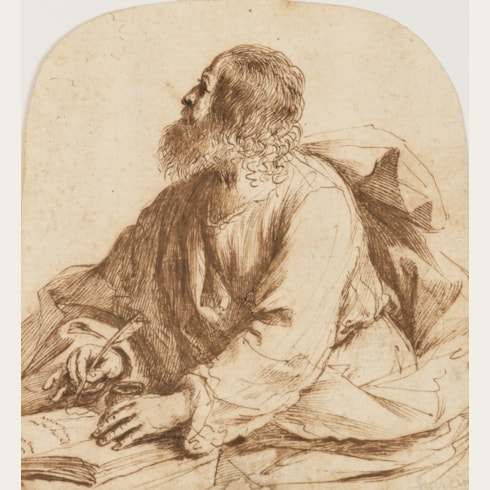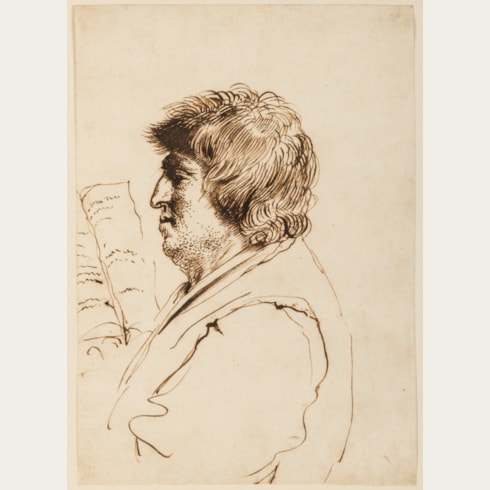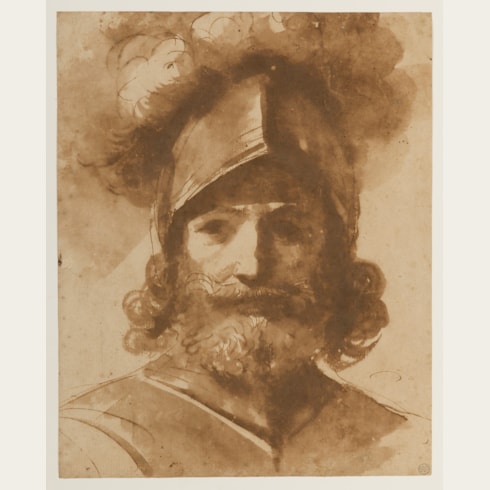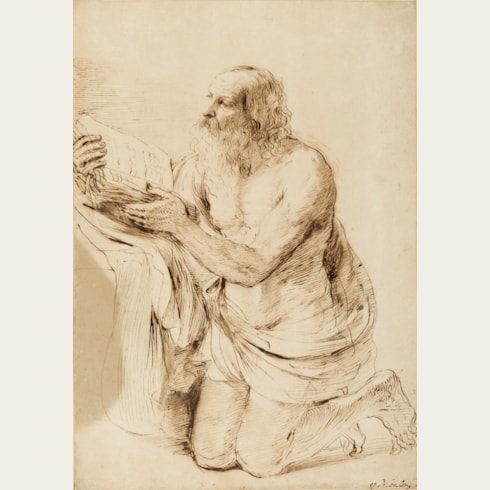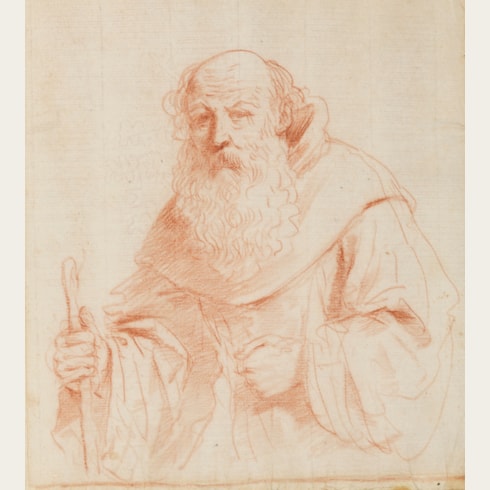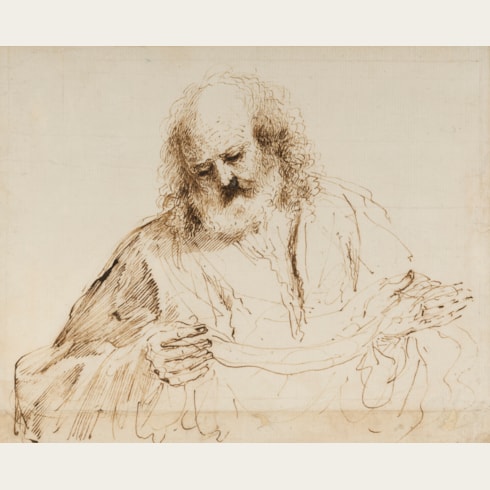Giovanni Francesco Barbieri GUERCINO
(Cento 1591 - Bologna 1666)
A Young Man with an Owl on a Stick
Inscribed B. del Guercino and numbered L20 on the verso.
225 x 155 mm. (8 7/8 x 6 1/8 in.)
ACQUIRED BY THE MUSEUM OF ART, RHODE ISLAND SCHOOL OF DESIGN, PROVIDENCE.
Nicholas Turner has written of Guercino’s genre drawings that ‘they are characterized by a rapid touch, an economy of means, and a remarkable acuteness of observation, many of them clearly based on scenes taken directly from life. The foibles of the men, women, and children of all rank who were his unwitting subjects are captured with great immediacy, which has always given these drawings a special appeal. Although the nobles, gentlefolk, and clergy, largely from his native Cento, came under his powerful scrutiny, the most frequent subjects were the peasant folk, or contadini, for whom it seems the painter had a particular affection.’
The vigorous and confident pen and wash technique of the present sheet provides a fine example of the gustosa facilità for which Malvasia praised the artist’s drawings. The effect of bright sunlight is created by the contrast of dark areas of different shades of brown wash, applied with the point of the brush, with the reserve of the paper left untouched to form highlights.
The inconography of the drawing is difficult to elucidate, although the presence of the owl, as a symbol of wisdom, may indicate that the man is a fortune-teller. (It has also been suggested that the man may be trying to ward off the malocchio, or evil eye, while owls were sometimes tied to poles at attract small birds such as larks by bird-hunters.) A similar subject is found in a recently identified early painting by Guercino of A Landscape with Rinaldo Corradino on a Mule, datable to c.1615-1617, which appeared at auction in 2003 and is now in the Pinacoteca Civica in Cento. The painting depicts Rinaldo Corradino - a close friend of Annibale Carracci, who made several caricature drawings of him - riding a mule and holding in front of him a staff on which rests a small owl. As Fausto Gozzi has noted of this painting, ‘[Guercino] is faithful to his story of Ronaldo Corradino’s journeys by mule, from one village to the next, laden with the apparatus of his work [including] a little owl, symbol of wisdom and therefore useful for foretelling the future in peasant markets.'
While Guercino’s genre drawings are hard to accurately date, the present sheet is likely to date from the early 1630’s8, and almost certainly to the twenty-year period when the artist was working in Cento, following his brief stay in Rome and before he transferred his studio to Bologna in the early 1640’s. As one scholar has aptly noted, ‘Given that Guercino traveled little and spent so much of his career in provincial Cento, it is no surprise that his caricatures and genre scenes reflect local life rather than political subjects. A gentle, sensitive humor and humanity characterize his work in this field and indeed pervade his entire graphic output.’
Giovanni Francesco Barbieri, known as Il Guercino (‘the squinter’) because he was cross-eyed, was by the second decade of the 17th century one of the leading painters in the province of Emilia. Born in Cento, a small town between Bologna and Ferrara, Guercino was largely self-taught, although his early work was strongly influenced by the paintings of Ludovico Carracci. In 1617 he was summoned to Bologna by Alessandro Ludovisi, the Cardinal Archbishop of Bologna, and there painted a number of important altarpieces, typified by the Saint William Receiving the Monastic Habit, painted in 1620 and now in the Pinacoteca Nazionale in Bologna. When Ludovisi was elected Pope Gregory XV in 1621, Guercino was summoned to Rome to work for the pontiff and his nephew, Cardinal Ludovico Ludovisi. It was in Rome that Guercino painted some of his most celebrated works, notably the ceiling fresco of Aurora in the Casino Ludovisi and the large altarpiece of The Burial and Reception into Heaven of Saint Petronilla for an altar in Saint Peter’s. The papacy of Gregory XV was short-lived, however, and on the death of the Pope in 1623 Guercino returned to his native Cento. He remained working in Cento for twenty years, though he continued to receive commissions from patrons throughout Italy and beyond, and turned down offers of employment at the royal courts in London and Paris. Following the death of Guido Reni in 1642, Guercino moved his studio to Bologna, where he received commissions for religious pictures of the sort that Reni had specialized in, and soon inherited his position as the leading painter in the city.
Guercino was among the most prolific draughtsmen of the 17th century in Italy, and his preferred medium was pen and brown ink, although he also worked in red chalk, black chalk, and charcoal. He appears to have assiduously kept his drawings throughout his long career, and to have only parted with a few of them. Indeed, more drawings by him survive today than by any other Italian artist of the period. On his death in 1666 all of the numerous surviving sheets in his studio passed to his nephews and heirs, the painters Benedetto and Cesare Gennari, known as the ‘Casa Gennari’.
The drawings of Guercino, which include figural and compositional studies, landscapes, caricatures and genre scenes, have always been coveted by later collectors and connoisseurs. Indeed, the 18th century amateur Pierre-Jean Mariette noted of the artist that ‘Ce peintre a outre cela une plume tout-à-faite séduisante’. The largest extant group of drawings by Guercino is today in the Royal Collection at Windsor Castle; these were acquired from the Gennari family by King George III’s librarian, Richard Dalton, between about 1758 and 1764.
Provenance
Literature
Exhibition


















